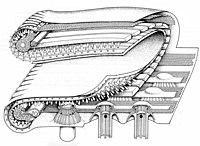fr
noms dans le fil d’Ariane


Stephanopogon ist eine aus sechs meeresbewohnenden Arten bestehende Protisten-Gattung, deren systematische Position innerhalb der Eukaryoten lange Zeit nicht klar war.
Stephanopogon-Arten sind 20 bis 50 Mikrometer groß, Alveolen und Infraciliatur fehlen. Es ist nur ein Zellkern vorhanden, dieser kann allerdings 2- bis 16-fach als Homokaryot vorliegen. Der Zellmund sitzt am Vorderende, die Cristae sind scheibenförmig. Die Mikrotubuli der Zellmembran sind längs ausgerichtet.
Die zahlreichen, in Reihen angeordneten, nicht flimmernden Geißeln weisen jeweils nur einzelne Kinetosome auf. Sie sind trompetenförmig in die Oberfläche der Zelle eingesenkt und werden durch strahlenförmig angeordnete Mikrotubuli gestützt.
Alle Arten leben bodennah (benthisch) im Meer bis in Tiefen von 100 Metern. Sie ernähren sich dort von Diatomeen, Flagellaten und Bakterien. Über ihre sexuelle Fortpflanzung ist nichts bekannt, eine Vermehrung per Zellteilung erfolgt nur im Cystenstadium.
Ursprünglich wurde die Gattung aufgrund einiger morphologischer Ähnlichkeiten zu den Wimperntierchen (Ciliata) gezählt, aufgrund des fehlenden zweiten Zellkerns als die scheinbar primitivsten Vertreter in einer Untergruppe Primociliata. Elektronenmikroskopische Untersuchungen zeigten jedoch das Fehlen noch weiterer wichtiger Merkmale der Wimpertierchen auf (Alveolen und Infraciliatur), weshalb sie seit den frühen 1980er Jahren aus ihnen ausgegliedert und unter anderem als eigenes Phylum Pseudociliata („Scheinwimpertierchen“) geführt wurden. Adl et al. hingegen stellten 2005 die Gattung als unklaren Ranges incertae sedis zu den Eukaryoten.
Voneinander unabhängige molekulargenetische Untersuchungen belegten 2008, dass Stephanopogon das Schwestertaxon der Gattung Percolomonas ist. Die aus den beiden Gattungen gebildete Klade wiederum ist das Schwestertaxon der Heterolobosea. Cavalier-Smith zufolge stellen sie in ihrer Gesamtheit die Percolozoa als Schwester der Euglenozoa.[1][2]
Neuere Systematiken verstehen sie als Teil der Heterolobosea und platzieren sie dort innerhalb der Gruppe Tetramitia.[3]
Die Gattung umfasst sechs beschriebene Arten: [1]
Stephanopogon ist eine aus sechs meeresbewohnenden Arten bestehende Protisten-Gattung, deren systematische Position innerhalb der Eukaryoten lange Zeit nicht klar war.
Stephanopogon is a genus of flagellated marine protist that superficially resembles a ciliate.
Stephanopogon closely resembles certain ciliates and was originally classified with them ([1], but is now considered related to heterolobosean flagellates. The cell is somewhat flattened, with multiple smooth flagella arranged in rows running from the front to the back, and has an anterior mouth supported by rods. They feed on bacteria, diatoms, and other smaller organisms. There are 2-16 nuclei, but they are not differentiated into macronuclei and micronuclei as occurs in ciliates. They have a cosmopolitan distribution.
Because nuclear dimorphism is absent, Stephanopogon had been regarded as an evolutionary intermediate between the ciliates and other protozoa, and possibly an ancestor of the animals as well. Corliss and Lipscomb showed that it is not cytologically similar to ciliates, lacking their complex pellicle and infraciliature.[2] Further electron microscopical studies added details to the understanding of the cytological organization of Stephanopogon.[3][4] Yubuki and Leander demonstrated that Stephanopogon is closely related to Percolomonas within the Heterolobosea. The bases of the flagella in both genera are attached to an electron dense cytoskeletal material,[5] but it has been argued that this is not an apomorphy of the clade [6]
It has recently been included as a heterolosean in the class Percolatea, along with Percolomonas.[7]
The genus contains 7 species: S. apogon Borror, 1965, S. colpoda Entz, 1884, S. mesnili Lwoff, 1923, S. minuta Lei et al., 1999, S. mobilensis Jones et Owen, 1974, S. paramesnili Lei et al., 1999 and S. pattersoni Lee et al., 2014 [8]

Stephanopogon is a genus of flagellated marine protist that superficially resembles a ciliate.
Los seudociliados (Pseudociliatida) forman un orden protista, con un género: Stephanopogon. Es un protozoo marino, unicelular, algo aplanado, multiflagelado, polinucleado (2 a 16 núcleos), que se parece mucho a ciertos ciliados y originalmente se clasificó con ellos. Los flagelos son lisos dispuestos en filas de adelante hacia atrás y la boca está sostenida con varillas. Se alimentan especialmente de bacterias y diatomeas. Los núcleos, a diferencia de los ciliados, están indiferenciados.
Pertenece a Percolozoa, un filo que durante su ciclo de vida alterna entre etapas ameboides, flagelados y quistes;[2][3] sin embargo, en este protozoo la etapa de ameboide no se ha observado, por lo que puede haberse perdido secundariamente.
Los seudociliados (Pseudociliatida) forman un orden protista, con un género: Stephanopogon. Es un protozoo marino, unicelular, algo aplanado, multiflagelado, polinucleado (2 a 16 núcleos), que se parece mucho a ciertos ciliados y originalmente se clasificó con ellos. Los flagelos son lisos dispuestos en filas de adelante hacia atrás y la boca está sostenida con varillas. Se alimentan especialmente de bacterias y diatomeas. Los núcleos, a diferencia de los ciliados, están indiferenciados.
Pertenece a Percolozoa, un filo que durante su ciclo de vida alterna entre etapas ameboides, flagelados y quistes; sin embargo, en este protozoo la etapa de ameboide no se ha observado, por lo que puede haberse perdido secundariamente.

ステファノポゴン (Stephanopogon) は、海の堆積物中に棲むやや変わった単細胞の原生生物である。外見的には繊毛虫に類似しており、かつてはそこに分類されていた。しかしその後はペルコロゾア門(phylum Percolozoa)に含める意見が提唱され[1]、細胞形態、分子系統の両側面からそれを支持する報告がなされている。
学名の語源は、stephan-o- = 冠、pogon = 髭。
細胞の大きさは長軸方向に 20–100 μm、形状は扁平で細胞の各所から鞭毛を生じる。特に細胞の腹側では 6–14 の列をなして多数の鞭毛を生じる。一方背側には鞭毛は少なく、前端部付近から生じるのみである。鞭毛の表面は滑らかで、鱗片や小毛などの修飾構造は無い。細胞前端部に細胞口を持ち、周囲は突起 (barb) で支持される。細胞は多核で 2–16 個の細胞核(個数は種によって異なる)を持つが、繊毛虫のような大核と小核の分化は見られない。ミトコンドリアを持ち、クリステは団扇型である。ゴルジ体はない。
ステファノポゴンは腹側の鞭毛を脚のように用いて基物の表面を移動する。従属栄養生物であり、バクテリアや珪藻、その他の小さな生物を捕食する。葉緑体や共生藻を持つものは知られていない。
ステファノポゴンは運動能力のある鞭毛虫態と、不動のシスト態を繰り返す生活環を持つ[2][3]。シスト化は無性的に行われる。有性生殖は知られていない。
2つの細胞核を持つ S. colpoda の場合、十分に成長した細胞の核は有糸分裂を繰り返して数を増やす。核分裂は同期しない。核が 12–16 個程度まで増殖すると細胞はシスト化し、細胞質分裂によりシスト内の細胞質が区切られる。区画数は細胞核の数に等しく、全ての区画が1個の細胞核を含むように仕切られる。その後それぞれの核は分裂して2個となり、再び鞭毛虫態の細胞が形成されて脱シストする。
細胞の形態や遊泳法、また細胞核が多核であることから、かつてステファノポゴンは Stylonychia や Euplotes のような下毛類の繊毛虫であると考えられた。一方で、前述のように細胞核の機能分化が見られないことから、ごく原始的な繊毛虫もしくは繊毛虫と他の原生生物との中間にあたる進化的位置を占めるのではないかと考えられたこともあった[4][3]。しかし1982年、Corliss と Lipscomb によって、ステファノポゴンと繊毛虫には関連性が無いことが示された[5]。これは繊毛(鞭毛)基部や、細胞膜を裏打ちするペリクル (pellicle) の構造の違いに基づくものである。
ステファノポゴンはミトコンドリアクリステ形状やゴルジ体を欠くことから、盤状クリステ類との近縁性が示唆されてもいた[6]。しかしその後もステファノポゴンの位置付けは定まらず、クロムアルベオラータやリザリアなど高次の分類を跨ってその系統的位置が議論されてきた。あるいは位置を定めず、「位置未定」(incertae sedis)の原生生物として扱われる場合も多かった[7]。
2008年にようやく分子系統解析が行われ、ヘテロロボサのペルコロモナス Percolomonas に近い生物であることが示された[8]。この結果はミトコンドリアや小胞体、鞭毛装置といった細胞小器官の特徴からも支持されている。
ステファノポゴン属としては2008年までに6種が記載されている。属内の分類形質となるのは細胞の大きさ、細胞口周囲の突起の形状、腹側の鞭毛列の数などである。ステファノポゴンの仲間は世界中の海洋に普通に分布するが、特に優占あるいは大発生する例は知られていない。
ステファノポゴン (Stephanopogon) は、海の堆積物中に棲むやや変わった単細胞の原生生物である。外見的には繊毛虫に類似しており、かつてはそこに分類されていた。しかしその後はペルコロゾア門(phylum Percolozoa)に含める意見が提唱され、細胞形態、分子系統の両側面からそれを支持する報告がなされている。
学名の語源は、stephan-o- = 冠、pogon = 髭。
스테파노포곤속(Stephanopogon)은 페르콜라테아류에 속하는 해양성의 독특한 원생생물 속의 일종이다. 특정 섬모충류와 닮았기 때문에 처음에는 섬모충류로 분류했지만 현재는 페르콜로조아 편모충류와 가까운 것으로 간주하고 있다. 최근 페르콜로모나스속(Percolomonas)과 함께 페르콜라테아강으로 분류하고 있다.[1]